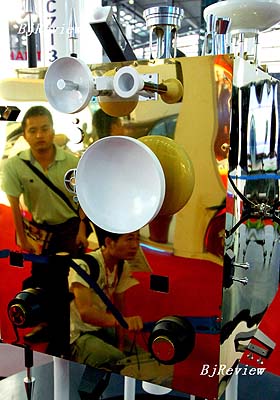|

The First Milestone: "Two Bombs and One Satellite"
"Two Bombs and One Satellite"refers to the atomic bomb, which exploded on October 16, 1964, the hydrogen bomb, which exploded on June 17, 1967, and a man-made satellite, which was successfully launched on April 24, 1970. Since the People's Republic of China was shrouded by the threat of nuclear attack when it was established, Chinese leaders realized that China must produce its own nuclear weapons to counteract these threats. The project of "two bombs and one satellite" set a solid foundation of sophisticated science and technology for China, and helped it become one of the great nations in the world.
The Second Milestone: Manned Space Flight
China successfully launched its first manned spacecraft Shenzhou-5 on October 15, 2003. The craft remained in space for 21 hours and 23 minutes, adding China to the list of countries to independently develop the technology of manned space flight, following the Soviet Union and the United States. Two years later, further advances were achieved in the history of manned space venture, from a single person to two persons, from one day to several days, and the activity sphere of astronauts has expanded from re-entry module to orbit module.
The Third Milestone: Lunar Orbiter Project
The lunar orbiter project has already completed the research for the technology of the Chang'e-1 satellite and the Long March 3A carrier rocket, and finished the construction of the launch site and ground application system. If the lunar orbiter project is successfully completed, which is scheduled to be around the year 2020, it will be the third milestone in China's space venture.
Three Steps of Lunar Orbiter Project
Hao Xifan, Deputy Director of the Lunar Orbiter Project Center of Commission of Science Technology and Industry for National Defense, said that the lunar orbiter project will follow three phases: orbiting, landing, returning. The entire project is expected to be completed around 2020.
The orbiting phase includes the launch of the first lunar probe, Chang'e-1.
The landing phase will include the launch of a soft lunar lander. After landing on the surface of the moon, the lander will release a lunar rover to conduct a detailed survey of the topography and geological structure of the landing site and its surrounding terrain.
The returning phase will include the launch of a lunar sampler, which will softly land on a specific area of lunar surface and collect rock and soil samples. This lander will then return to the Earth, bringing with it samples of lunar material for further study.
Four Missions of Chang'e-1
According to the plan, Chang'e-1 has four mission goals to accomplish.
The first is to obtain 3-D images of the lunar surface in order to precisely ascertain the basic structures and physiognomy of the lunar surface and to initially map the lunar geology and structural elements to provide information for the follow-on soft landing.
The second goal is to analyze 14 chemical elements and their distribution across the lunar surface as well as outline distribution maps of the elements.
Third, it will measure the depth of the lunar soil.
Finally, it will explore the space environment between the Earth and the moon, collect original data of solar wind activity and study the solar impact on the space environment between the Earth and the moon. No nation has achieved any of the first three goals until now. For the last mission, it will be the first time for China to obtain data of space environment from the geostationary orbit.
The Payloads in Chang'e-1
To finish these four missions, Chang'e -1 carries six kinds of payloads, including a total of 25 devices arranged in eight instruments.
-- Optical Imaging System
-CCD Stereo Camera
- Interferometer Spectrometer Imager
-- Laser Altimeter
-- Gamma-/X-Ray Spectrometers
-- Microwave Detector
-- Space Environment Monitor System
-High-Energy Solar Particle Detector
-Low-Energy Ion Detector
-- Payload Data Management System
Among these instruments, the CCD optical system will use a series of three 2-D original images of a target area, taken before, during and after flyover, to reconfigure a 3-D image of the lunar surface. This demands higher accuracy in latitude control and orbital determination.
The Interferometer Spectrometer Imager is a camera that obtains images based on the fact that different objects have different spectrum properties. It will be used to perform multi-spectral remote sensing of the lunar surface. By filling spectral information into the digital lunar terrains obtained through stereo imaging, scientists will be able to conduct research on the properties of regional lunar resources and materials.
The Laser Altimeter will be used to provide complementary data to the elevation data of lunar surface and to refine the lunar surface digital model.
The Gamma-/X-ray spectrometers can collect information on the distribution of different elements according to the differences of energy spectra of gamma- and X-rays emitted by various elements due to cosmic ray excitation.
Microwave Detector: The microwave/millimeter-wave radiometer is usually used on satellite. According to the different depths penetrating into lunar soil of microwaves in different bands, lunar soil depth data can be obtained by measuring the microwave radiation brightness of the lunar surface material in given bands. This is a kind of passive measurement. The microwave detector on Chang'e-1 will operate in four different frequency bands.
Space Environment Monitor System: This is mainly used to measure the contents of heavy ions, energy spectra of protons and contents and spatial distribution of low-energy ions in solar wind.
Compiled by Yuan Yuan
Source: (http://www.cnsa.gov.cn) | 